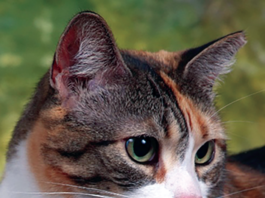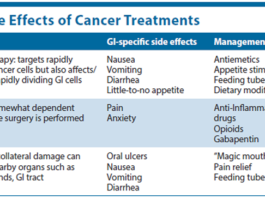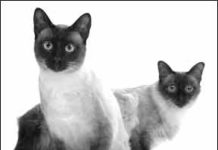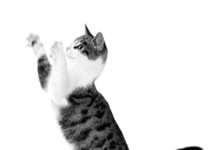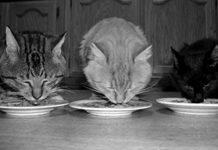You Can Prevent This Serious Disease
If you’ve resisted brushing your cat’s teeth, knowing how strenuously he’s likely to object, consider this: Periodontal disease, an often painful inflammation of the gums that can result in bone loss and destruction of oral tissue, is extremely common. In fact, it’s the most prevalent disease in companion animals and can pose serious health threats. “Periodontitis has been shown to play a role in such health problems as cardiovascular disease and diabetes,” says dental specialist Santiago Peralta, DVM, a Lecturer in Dentistry and Oral Surgery at the Cornell University College of Veterinary Medicine. This disease is, however, entirely preventable, according to the American Veterinary Dental College (AVDC). The best way to prevent periodontitis is by regular brushing and professional dental care.
They Jump, Paw, Cry, Stare and Meow
Considering that kittens vocalize to their mothers for everything they want, it’s not unusual for cats to meow or beg for food and attention from their owners. In cat-owning households, humans are the mother cats.
In The News: Do beta blockers improve the lives of heart patients?
Beta blockers have proven effective in treating some people with hypertrophic cardiomyopathy, but their effectiveness in cats with asymptomatic HCM has not been established. However, researchers at North Carolina State University are now studying cats being treated with the beta-blocker atenolol to better determine if early medical therapy improves their quality of life.
The Great Debate: Canned vs. Dry
With all the marketing claims about the virtues of canned and dry food, it can be daunting to choose between them. Which is better tasting and which is the better value? The answers just might surprise you. Nutritionist Joseph Wakshlag, DVM, Ph.D, Associate Professor at the Cornell University College of Veterinary Medicine, provides clarity in this Q. and A. to help you move past hype to good health for your cat.
The Best Candidate for Leashed Walks
If you have a confident cat, he may be the ideal candidate to join you for a daily walk. “Certainly, not all cats are suited to take on walks,” says Katherine A. Houpt, VMD, Ph.D., emeritus James Law Professor of Animal Behavior at the Cornell University College of Veterinary Medicine. “You need a bold and curious type of cat — the type who looks around in drawers, looks out the window and is not content to sit and purr. This is the type who will truly enjoy a leashed walk.”
Are Natural Preservatives Up to the Job?
Manufacturers add preservatives to foods to prevent spoilage caused by bacteria, molds, fungi, or yeast. The preservatives also slow or prevent changes in color, flavor, or texture, and maintain freshness by delaying the onset of rancidity. Artificial preservatives include sodium erythorbate, sodium nitrite, sodium benzoate, calcium sorbate, potassium sorbate, calcium propionate, BHA, BHT, and EDTA.
In The News: A Search to Detect Early Kidney Disease
Cats receiving treatment for hyperthyroidism, the overproduction of thyroid hormone, can develop decreased kidney function. However, today’s methods of predicting which cats will experience post-treatment kidney problems are cumbersome and impractical, the Morris Animal Foundation says. The foundation is sponsoring a study to test whether measuring a protein called TGF-beta in cat urine can reliably predict those at risk.
In The News: A Search to Detect Early Kidney Disease
Cats receiving treatment for hyperthyroidism, the overproduction of thyroid hormone, can develop decreased kidney function. However, today’s methods of predicting which cats will experience post-treatment kidney problems are cumbersome and impractical, the Morris Animal Foundation says. The foundation is sponsoring a study to test whether measuring a protein called TGF-beta in cat urine can reliably predict those at risk.
‘Kitty cams’ reveal their hidden world
Two thousand hours of video recorded by “kitty cams” from the National Geographic Society have uncovered the lives of indoor cats who are allowed outdoors.
In The News: The Risks of Upper Respiratory Infections
Signs that your cat has an infection of his upper respiratory tract can mimic the ones you suffer with a cold: watery eyes, runny nose, wheezing, sneezing and coughing. Just as you’re likely to rebound in a few days, in most instances a cat will, too.
In The News: The mysterious purr eludes translation
Conventional wisdom has long held that purring is a sign of contentment, a cat purring on a sunny windowsill by the owner’s side being a perfect example. However, researchers have found that cats also purr in other, often surprising situations — when giving birth and nursing, when under duress and even when dying.
A Deadly Threat to Outdoor Cats
Cats whose breed developed in frigid areas of the world are likely to tolerate cold weather better than cats whose origins can be traced to more temperate regions. But even the fattest, furriest Maine coon will have only a slight edge over a trim, thin-coated Siamese when it comes to prolonged exposure to the biting winds, ice, snow and sleet that come with winter.



